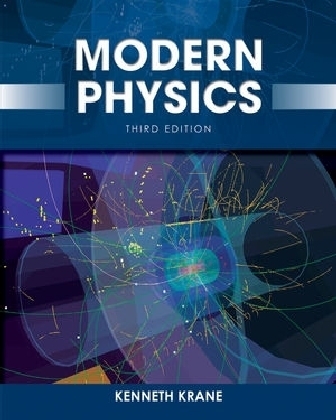
Modern Physics
John Wiley & Sons Inc (Verlag)
978-1-118-06114-5 (ISBN)
- Titel ist leider vergriffen;
keine Neuauflage - Artikel merken
Kenneth S. Krane is Professor of Physics (Emeritus) at Oregon State University, where he has served on the faculty since 1974, including 14 years as Department Chair. He received the Ph.D. in nuclear physics from Purdue University in 1970 and held postdoctoral research positions at the Los Alamos National Laboratory and the Lawrence Berkeley National Laboratory before joining the faculty at Oregon State. His research involves nuclear structure and nuclear spectroscopy, and has led to more than 100 papers in refereed journals and 30 years of funding in experimental nuclear physics from NSF and DOE. He was selected to be a Fellow of the American Physical Society by the Division of Nuclear Physics. He is also involved in education research and curriculum development and has held numerous NSF grants supporting those activities. He has served as chair of the APS Committee on Education, the APS Forum on Education, and the AIP Advisory Committee on Physics Education. From 1995-2006 he was the director of the Workshop for New Faculty in Physics and Astronomy, a national mentoring program for college and university faculty. In 2004 he was awarded the Millikan Medal of the American Association of Physics Teachers in recognition of his contributions to physics teaching.
Chapter 1. The Failures of Classical Physics 1.1 Review of Classical Physics 1.2 The Failure of Classical Concepts of Space and Time 1.3 The Failure of the Classical Theory of Particle Statistics 1.4 Theory, Experiment, Law Summary Questions Problems Chapter 2. The Special Theory of Relativity 2.1 Classical Relativity 2.2 The Michelson-Morley Experiment 2.3 Einstein's Postulates 2.4 Consequences of Einstein's Postulates 2.5 The Lorentz Transformation 2.6 The Twin Paradox 2.7 Relativistic Dynamics 2.8 Conservation Laws in Relativistic Decays and Collisions 2.9 Experimental Tests of Special Relativity Summary Questions Problems Chapter 3. The Particlelike Properties of Electromagnetic Radiation 3.1 Review of Electromagnetic Waves 3.2 The Photoelectric Effect 3.3 Thermal Radiation 3.4 The Compton Effect 3.5 Other Photon Processes 3.6 What Is a Photon? Summary Questions Problems Chapter 4. The Wavelike Properties of Particles 4.1 DeBroglie's Hypothesis 4.2 Experimental Evidence for DeBroglie Waves 4.3 Uncertainty Relationships for Classical Waves 4.4 Heisenberg Uncertainty Relationships 4.5 Wave Packets 4.6 The Motion of a Wave Packet 4.7 Probability and Randomness Summary Questions Problems Chapter 5. The Schrodinger Equation 5.1 Behavior of a Wave at a Boundary 5.2 Confining a Particle 5.3 The Schrodinger Equation 5.4 Applications of the Schrodinger Equation 5.5 The Simple Harmonic Oscillator 5.6 Steps and Barriers Summary Questions Problems Chapter 6. The Rutherford-Bohr Model of the Atom 6.1 Basic Properties of Atoms 6.2 Scattering Experiments and the Thomson Model 6.3 The Rutherford Nuclear Atom 6.4 Line Spectra 6.5 The Bohr Model 6.6 The Franck-Hertz Experiment 6.7 The Correspondence Principle 6.8 Deficiencies of the Bohr Model Summary Questions Problems Chapter 7. The Hydrogen Atom in Wave Mechanics 7.1 A One-Dimensional Atom 7.2 Angular Momentum in the Hydrogen Atom 7,3 The Hydrogen Atom Wave Functions 7.4 Radial Probability Densities 7.5 Angular Probability Densities 7.6 Intrinsic Spin 7.7 Energy Levels and Spectroscopic Notation 7.8 The Zeeman Effect 7.9 Fine Structure Summary Questions Problems Chapter 8. Many-Electron Atoms 8.1 The Pauli Exclusion Principle 8.2 Electronic States in Many-Electron Atoms 8.3 Outer Electrons: Screening and Optical Transitions 8.4 Properties of the Elements 8.5 Inner Electrons: Absorption Edges and X Rays 8.6 Addition of Angular Momenta 8.7 Lasers Summary Questions Problems Chapter 9. Molecular Structure 9.1 The Hydrogen Molecule 9.2 Covalent Bonding in Molecules 9.3 Ionic Bonding 9.4 Molecular Vibrations 9.5 Molecular Rotations 9.6 Molecular Spectra Summary Questions Problems Chapter 10. Statistical Physics 10.1 Statistical Analysis 10.2 Classical and Quantum Statistics 10.3 The Density of States 10.4 The Maxwell-Boltzmann Distribution 10.5 Quantum Statistics 10.6 Application of Bose-Einstein Statistics 10.7 Application of Fermi-Dirac Statistics Sumary Questions Problems Chapter 11. Solid-State Physics 11.1 Crystal Structures 11.2 The Heat Capacity of Solids 11.3 Electrons in Metals 11.4 Band Theory of Solids 11.5 Superconductivity 11.6 Intrinsic and Impurity Semiconductors 11.7 Semiconductor Devices 11.8 Magnetic Materials Questions Problems Chapter 12. Nuclear Structure and Radioactivity 12.1 Nuclear Constituents 12.2 Nuclear Sizes and Shapes 12.3 Nuclear Masses and Binding Energies 12.4 The Nuclear Force 12.5 Quantum States in Nuclei 12.6 Radioactive Decay 12.7 Alpha Decay 12.8 Beta Decay 12.9 Gamma Decay and Nuclear Excited States 12.10 Natural Radioactivity Summary Questions Problems Chapter 13. Nuclear Reactions and Applications 13.1 Types of Nuclear Reactions 13.2 Radioisotope Production in Nuclear Reactions 13.3 Low-Energy Reaction Kinematics 13.4 Fission 13.5 Fusion 13.6 Nucleosynthesis 13.7 Applications of Nuclear Physics Summary Questions Problems Chapter 14. Elementary Particles 14.1 The Four Basic Forces 14.2 Classifying Particles 14.3 Conservation Laws 14.4 Particle Interactions and Decays 14.5 Energy and Momentum in Particle Decays 14.6 Energy and Momentum in Particle Reactions 14.7 The Quark Structure of Mesons and Baryons 14.8 The Standard Model Summary Questions Problems Chapter 15. Cosmology: The Origin and Fate of the Universe 15.1 The Expansion of the Universe 15.2 The Cosmic Microwave Background Radiation 15.3 Dark Matter 15.4 The General Theory of Relativity 15.5 Tests of General Relativity 15.6 Stellar Evolution and Black Holes 15.7 Cosmology and General Relativity 15.8 The Big Bang Cosmology 15.9 The Formation of Nuclei and Atoms 15.10 Experimental Cosmology Summary Questions Problems Appendix A. Constants and Conversion Factors Appendix B. Complex Numbers Appendix C. Periodic Table of the Elements Appendix D. Table of Atomic Masses Answers to Odd-Numbered Problems
| Erscheint lt. Verlag | 14.9.2012 |
|---|---|
| Verlagsort | New York |
| Sprache | englisch |
| Maße | 203 x 261 mm |
| Gewicht | 1110 g |
| Themenwelt | Naturwissenschaften ► Physik / Astronomie ► Allgemeines / Lexika |
| ISBN-10 | 1-118-06114-4 / 1118061144 |
| ISBN-13 | 978-1-118-06114-5 / 9781118061145 |
| Zustand | Neuware |
| Haben Sie eine Frage zum Produkt? |
aus dem Bereich



